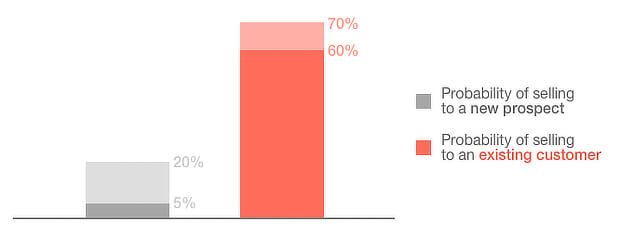By nature, humans are creatures of habit. Of course, this is no secret to parents of young children. All it takes is a few cycles of listening to the Thomas The Tank Engine theme song over and over and over and over and over and over for parents to learn that kids like what’s familiar.
Yes, kids love watching the same movie, playing with the same toys, and eating the same kinds of foods repeatedly. Why? Because it makes them feel good, and positive experiences breed habits.
Interestingly, these loyal fans of whatever they love so much as children grow up one day to become adult customers one day. Customers who, believe it or not, have the same childhood tendencies of going back to things they love over and over and over.
What we’re trying to say here is, loyal Thomas the Tank Engine fans become loyal customers.
Sort of.
What is customer loyalty?
Loyalty is an emotion that stems from feeling engaged in something or someone. When you give a customer an incentive to come back, and they willingly come back repeatedly, this is known as customer loyalty.
Their loyalty stems from associating positive experiences with your company and can be one of the most significant assets to your business’s success.
While bringing in new customers should unquestionably be a part of your existing business plan, you’d be foolish not to recognize the incredible value of the ones that you already have. Statistically, the majority of your future profits will come from your existing customers over new ones. That is if you know how to keep them coming back.
So, how do you go about creating loyal customers who come back?
The answer lies in customer loyalty programs.
What are customer loyalty programs?
A customer loyalty program is a program set in place that rewards customers for frequent purchases. Think of it as matching s customer’s generosity by offering things like free goods, discounts, customer support, or VIP access. The idea is to incentivize more customer spending and greater engagement by giving them a return on their purchase.
There are several different kinds of customer loyalty programs out there, from points-based loyalty programs to VIP access programs. The type of program you choose to implement at your company will depend on your business model. For a list of different loyalty programs to consider for your business, check out this blog post from Clarus Commerce.
How successful are customer loyalty programs?
The effectiveness of loyalty programs is undeniable when you look at the numbers. Your chances of selling a product to an existing loyal customer are significantly higher than selling to new prospects with whom you haven’t established trust yet.

Source: Markinblog
When you convert a new customer into a loyal one, not only will they will continue to return to your company, but they’ll tell their colleagues, friends, and family about you too. 60% of these customers to be exact.
A recent national survey conducted by Yotpo revealed that 52.3% of customers would join a loyalty rewards program, and 39.4% will spend more on a product with that company even if they can find a lower price with a competitor.

Looking at loyalty program statistics makes it evident that there has never been a more crucial time than now to start a program of your own. The evidence shows that now is the time to cultivate your customers’ loyalty through a strategic loyalty program. Nowadays, customers expect a reward for their ongoing business.
If you don’t have any sort of loyalty program in place, nothing will stop them from changing to a competitor who does.
Yet, implementing a customer loyalty program alone isn’t enough. To make sure that your strategy is working, you need to measure the effectiveness of your loyalty rate. The most successful loyalty programs are the ones that have access to their insights. The great news is measuring customer loyalty has never been easier.
How to Measure Your Customers’ Loyalty
You should be looking at several different metrics when determining whether your customers give you the kind of loyalty you want.
Customer Lifetime Value (CLV)
A huge part of measuring customer loyalty, whether you have a loyalty program in place yet or not, is by calculating how much a customer is worth to your business throughout your entire future relationship. A customer lifetime value number is defined by the monetary value they will bring to your future profits.
However, it’s important to note that customer profitability shouldn’t be confused with customer lifetime value. CP focuses on the past, while CLM focuses on the future. Think of it as a forecast for how much of an asset you predict your customer is in the years to come.
Net Promoter Score (NPS)
This score is a direct reflection of how much your customers are willing to vouch for you. If you’ve ever seen a customer survey that includes the question “On a scale of 1 to 10, how likely are you to recommend our business to someone else?” then you can be sure it’s for the purpose of determining their NPS.
In short, an NPS score is calculated by subtracting the number of customers who gave a six or below (detractors) from the number of people who gave a nine or above (promoters.) Ideally, your NPS score should be above 70 to show that your efforts are working.
Redemption Rate
If you implement a customer loyalty program that offers reward points or coupons, it’s essential to measure whether your customers are using them. If you find that the number of rewards being redeemed is significantly lower than the amount you’re giving out, then you’ll need to identify what the problem is.
Participation Rate
One of the most obvious ways to tell if your customers are loyal is by measuring how many of them participate in your loyalty program. If only a small amount of your customers are willing to partake in a program that involves buying more from you, then it’s time to reevaluate.
Engagement Rate
Being enrolled in your loyalty program doesn’t necessarily mean that your customers are engaging in it. You must look at your metrics to determine whether your customers are redeeming their rewards.
The Most Successful Businesses Know How To Measure Customer Loyalty
By measuring your customers’ loyalty, you’ll be able to identify your weak spots that call for improvement. Ultimately, the more customer loyalty you have, the more that your customers:
- Engage
- Make repeat purchases
- Recommend You To Their Friends and Colleagues
- Redeems Rewards
Ultimately, measuring your business’s success starts with measuring your customers’ loyalty.
![[Customer Story] Why TestDome Considers FastSpring a Real Partner](https://fastspring.com/wp-content/themes/fastspring-bamboo/images/promotional/2023/FastSpring-TestDome-blog-thumbnail.jpg)




